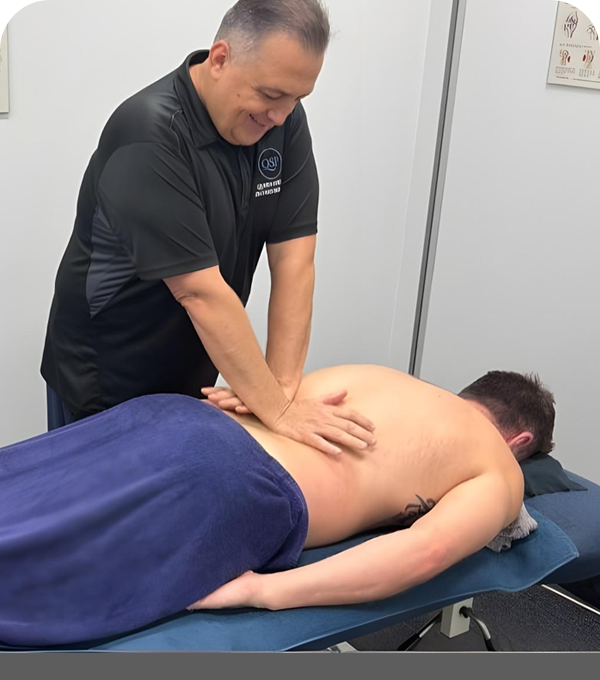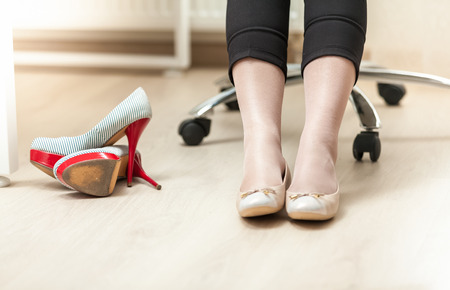

Plantar Fasciitis/
Heel Pain

You leap out of bed in the morning and you get stabbing pains in your heels or the arches of your feet. You hobble a few steps, and then hobble a few more until the pain reduces. Most of the day your feet feel OK …except when you tackle stairs or when you have been sitting for a while when the pain makes a reappearance.
Pain in your heel or the bottom of your foot is most commonly caused by Plantar Fasciitis. Your Plantar Fascia is the ligament that goes from the underneath of your heel to your toes. If you strain it, micro tears can form, which leads to swelling and sharp pain.
While most people experience the pain in their heel, some also get pain through to the arch of their foot. In about 70% of cases, the pain is in both feet, making walking a very painful experience.
You most commonly notice the pain first thing in the morning when you get out of bed and it reduces as your feet warm up with movement. It can reappear during the day after periods of rest or sitting, if you have been standing for a while, or when climbing stairs or ladders.
Plantar Fasciitis is more common in middle-aged people, although it can also affect younger people who use their feet a lot like joggers, dancers, or soldiers. That’s why it is also often called Joggers Heel.
Causes of Plantar Fasciitis
While the actual causes of plantar fasciitis are not known, there are risk factors that will increase the likelihood of you getting plantar fasciitis.
- Overuse – excessive running, walking or dancing, or changing your training pattern so you dramatically increase hill running (for example).
- Standing on hard surfaces
- Flat feet or high foot arches (this is one time when average is better!)
- Middle age
- Being overweight
- Tight Achilles tendons or calf muscles
- Your feet roll in when you walk or run
- Ill-fitting shoes, worn out or unsupportive footwear such as thongs/slides
- Walking barefoot on hard surfaces
- Pregnancy
First aid for Plantar Fasciitis
Generally, plantar fasciitis is gradual onset, which means it gradually increases in severity over time. If you ignore it and try to run through the pain, then the symptoms can get worse, ultimately leading to you changing your gait, limiting your activity or triggering the growth of heel spurs.
For initial symptoms, you need to rest, apply ice packs (15 minutes at a time every 2-3 hours), and take anti-inflammatory painkillers such as ibuprofen.
You don’t need a referral from a doctor to see a physiotherapist. If the pain is moderate then you can seek treatment with your Physiotherapist immediately as the sooner you begin treatment, the sooner you will experience relief.
Occasionally your plantar fascia can snap and you could hear a clicking or snapping sound, accompanied by swelling, intense pain and significant swelling. You need to see a doctor urgently if this occurs.
Physiotherapy & Treatment Options
Your physiotherapist will assess the extent of your injury, and will explore the causes of your injury.
Depending on your symptoms, you may have the soles of your feet taped or strapped to support your feet and reduce pain. You may also need to wear a plantar fasciitis brace or heel cups in the initial stages of healing.
Your physiotherapist will take you through a number of gentle stretching exercises for your feet, as well as exercises to address any tight Achilles tendons or calf muscles.
We will combine these with pain reduction techniques that you can do at home such as rolling your foot on a frozen water bottle or frozen golf ball to help ice your injury site.
Massage, joint mobilisation techniques, dry needling and ultrasound therapy will also be used to reduce swelling and restore movement.
For your footwear, we recommend you replace your joggers every 650km of use, and only wear shoes that support your feet while healing. Definitely no thongs or slides!
It also helps to put your shoes on first thing in the morning, before you take your first steps. Avoid barefoot walking on tiles or hard surfaces while you heal.
If the cause of your injury is your feet shape or foot pronation, you may need special orthotics. If this is indicated, we would conduct a walk/run assessment on you and have you analysed by our Gaitscan technology for the development of custom made orthotics.
To maintain your fitness during your treatment, we recommend swimming and cycling. Don’t return to running until you have been pain free for at least one week, and then only run on soft surfaces until you rebuild your strength and stamina. If pain is felt at any time, then go back to swimming and cycling rather than running.
Unfortunately, Plantar Fasciitis is a long-term injury, and may take a number of months to fully heal even with the most aggressive treatments.
Things to Remember
- Plantar Fasciitis is the most common cause of heel and arch pain, and is caused by micro tears to the plantar fascia.
- It is a gradual onset injury and causes sharp pain when taking the first few steps in the morning or after rest.
- Physiotherapy can treat plantar fasciitis, while reducing pain and increasing movement during healing.
- Your physiotherapist may advise you of techniques for the improvement of your walk/running style, or provide you with solutions for arch support, to help prevent further reoccurrence.
- Healing may take many months for full recovery.

